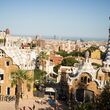Park Güell History
What is Park Güell?
Barcelona's Park Güell is a park designed by the famous Catalan architect Antoni Gaudí. It is world-famous for its terrace with undulating mosaic benches offering an unforgettable view of Barcelona, its famous salamander, its two Modernist pavilions and its extraordinary garden. The Modernist section of the park requires a Park Güell ticket.
The origin of Park Güell
The origins of Park Güell go back much further than the date on which its construction began. It began with a small sign of chance that would lead to a long complicity between Eusebi Güell, the future patron of the arts, and Antoni Gaudí, the architect of the park.
The story began in 1878 when Güell saw a window that Gaudí had created for the glove merchant Esteve Comella at the Universal Exhibition in Paris.
Following this meeting, Güell was captivated by Gaudí's talent and gradually entrusted him with the construction of his new home (the Palau Güell), the furniture for the pantheon chapel of the "Palau de Sobrellano", a wine cellar, a church (the Colonia Güell) and, finally, in 1900, the design and construction of Park Güell.
Eusebi Güell wanted to build a housing project for Barcelona's aristocrats on a large estate called the Bare Mountain. Gaudí, for his part, had in mind the concept of the Garden City, which was in vogue in England at the end of the 19th century. A sort of rational and hygienic city, located in the countryside, offering a balance between jobs and housing, agriculture and industry. Gaudí was inspired by this English model of the "Garden City", from which he ultimately retained only the anglicised name "Park Güell" instead of "Parque Güell" in Catalan.
The original plan called for 60 triangular plots of land to house luxury homes, with a network of roads, viaducts, and staircases to accommodate the rugged topography of the land. In the spirit of Gaudí, the future houses were to be bright and all have a view of the sea. Concerned about local biodiversity, the vegetation had to be preserved as much as possible during the earthworks and then reinforced afterwards. The gamble paid off!

The construction of Park Guell
The construction of Park Güell began in 1900 and included a drainage system, viaducts and part of the esplanade.
In 1902, the first plot of land was bought by a friend of Gaudí, Martí Trias i Domènech, who commissioned the architect Juli Batllevell to build his villa there.
In 1903, an article published in the Yearbook of the Order of Architects stated that the two entrance pavilions, the main staircase, the outer fence, the shelter, the viaducts and part of the large esplanade had been completed.
In 1906 Gaudí moved into the house that was to become the Gaudí House-Museum, where he lived for many years.
In 1907, the first events were held in the Greek Theatre Square, which became the Nature Square.
In 1914 the serpentine bench made of multicoloured ceramics that surrounds the Nature Square is completed.

From the failure of the housing project to the public park
A bold and innovative garden city concept, a breathtaking construction, but a poorly thought-out real estate project. In 1914, only 2 of the 60 houses planned were sold. The park was far from the centre of Barcelona, the means of transport were insufficient, and the so-called emphyteutic sales contracts discouraged potential buyers.
That same year the work was abandoned. Now open to the public, the park was a huge popular success. Over the years, it became one of the city's main tourist attractions.
After Eusebi Güell's death in 1918, his heirs donated the park to Barcelona City Council in 1922.
In 1926 the Park Güell officially became a municipal park, the house of the Güell family a public school (Escola Baldiri Reixac) and the area to the right of the entrance an ornamental garden.
In 1963 the Friends of Gaudí Association bought Gaudí's house and turned it into a house-museum in memory of the architect.
In 1984 Park Guell was declared a World Heritage Site by UNESCO, a worldwide recognition for these two visionary creators.
